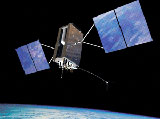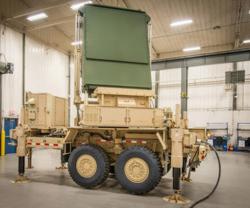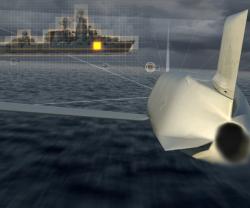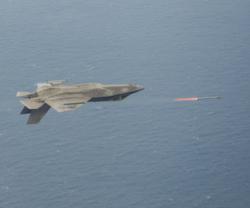Lockheed Martin: Design Milestone for GPS III
07.07.2011 Products
Lockheed Martin successfully completed, on-schedule, a System Design Review (SDR) for the Global Positioning System (GPS) IIIB satellite increment under the U.S. Air Force's next generation GPS III program.
GPS III will improve position, navigation and timing services and provide advanced anti-jam capabilities yielding superior system security, accuracy and reliability for users around the globe.
Lockheed Martin Space Systems is under contract to produce the first 2 of a planned 8 GPS IIIA satellites, with first launch projected for 2014.
The contract, which features a "back to basics" acquisition approach, includes a Capability Insertion Program (CIP) designed to mature technologies and perform rigorous systems engineering for future GPS III increments.
An important milestone that precedes the Preliminary Design Review, the GPS IIIB SDR, established requirements for the capability insertion planned for the follow-on GPS IIIB satellites and validated the satellite design will meet the ever increasing demand of more than one billion GPS users worldwide.
"This milestone comes at a pivotal time when the need to affordably and predictably enhance the GPS constellation's capabilities is at an all time high," said Lt. Col. Don Frew, the U.S. Air Force's GPS III Program Manager. "Thanks to hard work from the entire government and industry GPS III team, we have a solid, low-risk path to introduce critical new capabilities to billions of military, civil and commercial GPS users."
GPS IIIA will deliver signals three times more accurate than current GPS spacecraft and provide three times more power for military users, while also enhancing the spacecraft's design life and adding a new civil signal designed to be interoperable with international global navigation satellite systems. GPS IIIB will provide higher power modernized signals, a fully digital navigation payload capable of generating new navigation signals after launch and a Distress Alerting Satellite System payload that relays distress signals from emergency beacons back to search and rescue operations.
The Lockheed Martin-led GPS III team, which includes ITT of Bloomfield, New Jersey, and General Dynamics of Scottsdale, Arizona, completed the milestone with the U.S. Air Force at Lockheed Martin's facilities in Newtown, Pennsylvania. Representatives from the U.S. Air Force's GPS Directorate, Air Force Space Command, the Defense Contract Management Agency, the Federal Aviation Administration, Department of Defense and user communities participated in the review.
"Working together with the U.S. Air Force and GPS user communities, this milestone validates that we have developed the most affordable and lowest risk solution to introducing vital new capabilities for the GPS constellation," said Keoki Jackson, Lockheed Martin's GPS III Program Manager. "We understand the importance of GPS to our nation and the world, and we are laser focused on executing the entire GPS III program to meet the world's global navigation and timing needs for the next 30 years."
Meanwhile, Lockheed Martin is progressing steadily on the GPS IIIA program and is on schedule to deliver the first satellite for launch in 2014. In August of 2010, the joint government and industry team completed a highly successful critical design review, which validated the detailed GPS IIIA design and allowed the program to begin the transition to the production phase. The program has now switched its focus from design to manufacturing and has already completed 90 percent of the program's 59 manufacturing readiness reviews.
With a focus on affordability and risk reduction, the GPS III team is developing a GPS Non-Flight Satellite Testbed (GNST), which will serve as the program's ground pathfinder and vehicle demonstrator for the first complete GPS IIIA satellite. The entire GPS III development and production sequence will utilize the GNST to provide space vehicle design level validation; early verification of ground, support, and test equipment; and early confirmation and rehearsal of transportation operations.
Most recently, GPS III subcontractor ATK shipped the GNST core structure to Lockheed Martin in May. The GNST will run through the same steps of the production flow as the flight vehicles, including environmental testing at Lockheed Martin factories in Newtown, Pennsylvania, and Littleton, Colorado, followed by processing at Cape Canaveral Air Force Station, Fla. The team is on track to deliver the GNST to the new Littleton, Colorado, GPS Processing Facility (GPF) in December 2011.
GPS III will improve position, navigation and timing services and provide advanced anti-jam capabilities yielding superior system security, accuracy and reliability for users around the globe.
Lockheed Martin Space Systems is under contract to produce the first 2 of a planned 8 GPS IIIA satellites, with first launch projected for 2014.
The contract, which features a "back to basics" acquisition approach, includes a Capability Insertion Program (CIP) designed to mature technologies and perform rigorous systems engineering for future GPS III increments.
An important milestone that precedes the Preliminary Design Review, the GPS IIIB SDR, established requirements for the capability insertion planned for the follow-on GPS IIIB satellites and validated the satellite design will meet the ever increasing demand of more than one billion GPS users worldwide.
"This milestone comes at a pivotal time when the need to affordably and predictably enhance the GPS constellation's capabilities is at an all time high," said Lt. Col. Don Frew, the U.S. Air Force's GPS III Program Manager. "Thanks to hard work from the entire government and industry GPS III team, we have a solid, low-risk path to introduce critical new capabilities to billions of military, civil and commercial GPS users."
GPS IIIA will deliver signals three times more accurate than current GPS spacecraft and provide three times more power for military users, while also enhancing the spacecraft's design life and adding a new civil signal designed to be interoperable with international global navigation satellite systems. GPS IIIB will provide higher power modernized signals, a fully digital navigation payload capable of generating new navigation signals after launch and a Distress Alerting Satellite System payload that relays distress signals from emergency beacons back to search and rescue operations.
The Lockheed Martin-led GPS III team, which includes ITT of Bloomfield, New Jersey, and General Dynamics of Scottsdale, Arizona, completed the milestone with the U.S. Air Force at Lockheed Martin's facilities in Newtown, Pennsylvania. Representatives from the U.S. Air Force's GPS Directorate, Air Force Space Command, the Defense Contract Management Agency, the Federal Aviation Administration, Department of Defense and user communities participated in the review.
"Working together with the U.S. Air Force and GPS user communities, this milestone validates that we have developed the most affordable and lowest risk solution to introducing vital new capabilities for the GPS constellation," said Keoki Jackson, Lockheed Martin's GPS III Program Manager. "We understand the importance of GPS to our nation and the world, and we are laser focused on executing the entire GPS III program to meet the world's global navigation and timing needs for the next 30 years."
Meanwhile, Lockheed Martin is progressing steadily on the GPS IIIA program and is on schedule to deliver the first satellite for launch in 2014. In August of 2010, the joint government and industry team completed a highly successful critical design review, which validated the detailed GPS IIIA design and allowed the program to begin the transition to the production phase. The program has now switched its focus from design to manufacturing and has already completed 90 percent of the program's 59 manufacturing readiness reviews.
With a focus on affordability and risk reduction, the GPS III team is developing a GPS Non-Flight Satellite Testbed (GNST), which will serve as the program's ground pathfinder and vehicle demonstrator for the first complete GPS IIIA satellite. The entire GPS III development and production sequence will utilize the GNST to provide space vehicle design level validation; early verification of ground, support, and test equipment; and early confirmation and rehearsal of transportation operations.
Most recently, GPS III subcontractor ATK shipped the GNST core structure to Lockheed Martin in May. The GNST will run through the same steps of the production flow as the flight vehicles, including environmental testing at Lockheed Martin factories in Newtown, Pennsylvania, and Littleton, Colorado, followed by processing at Cape Canaveral Air Force Station, Fla. The team is on track to deliver the GNST to the new Littleton, Colorado, GPS Processing Facility (GPF) in December 2011.
Latest news
Latest events
IDEF 2025 Turkey - International Defence Industry Fair
22 - 27 Jul 2025Istanbul Expo Center - TurkeyDSEI 2025
09 - 12 Sep 2025Excel, London - United KingdomIntersec Saudi Arabia
29 Sep - 01 Oct 2025Riyadh International Exhibition & Convention Centre - Saudi ArabiaDubai International Air Chiefs’ Conference (DIACC 2025)
16 Nov 2025Atlantis, The Palm Dubai - United Arab Emirates






















